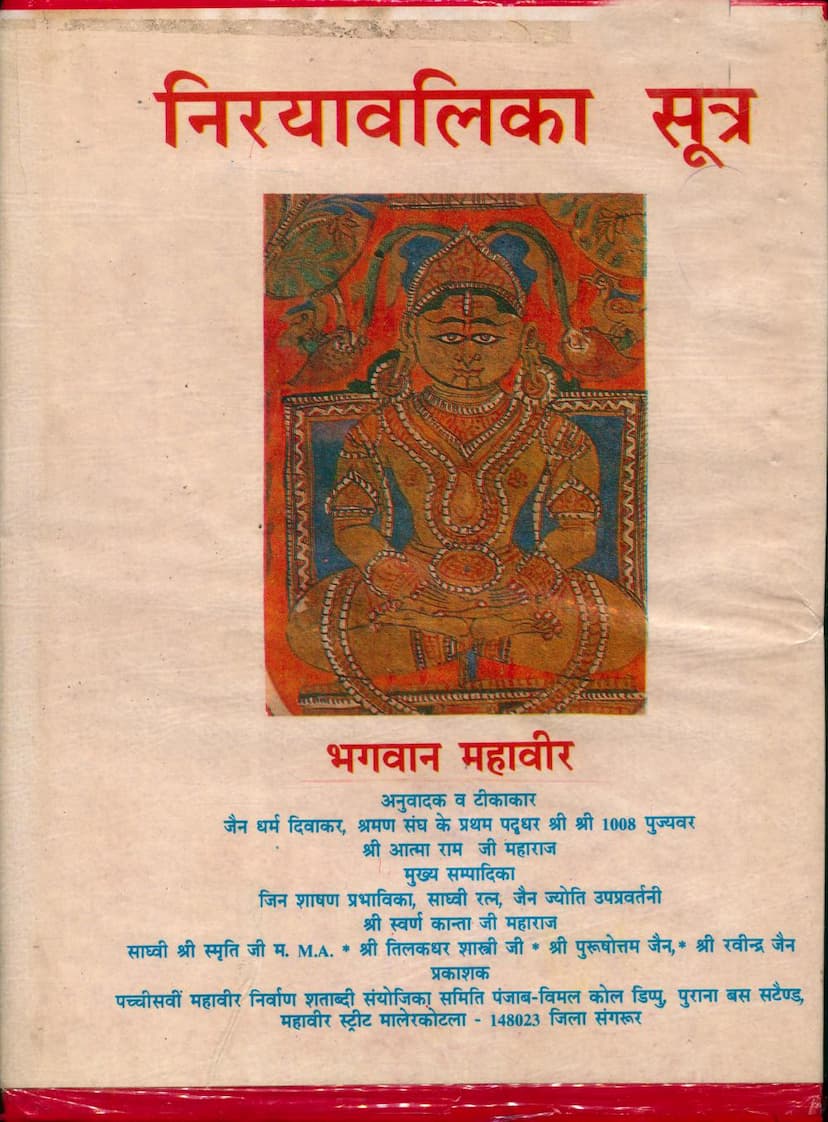Nirayavalika Sutra
Added to library: September 2, 2025

Summary
Nirayavalika Sutra: A Comprehensive Summary
The Nirayavalika Sutra, part of the Jain Agam literature, is a significant text within the "Dharma Kathaanuyoga" (narrative exposition of Dharma). It is considered an Upanga (subsidiary scripture) to the Antakrida Sutra. The text provides historical accounts of religious practice and the strong aspiration for liberation (moksha) among people during the time of Lord Mahavir. It details how princes and princesses renounced their worldly lives and embraced asceticism to achieve their spiritual goals.
Authorship and Publication:
- Authors/Translators/Commentators: Acharya Samrat Pujya Shri Atmaramji Maharaj (translator and commentator), Mahashramani Shri Swarnakanta Ji Maharaj (chief editor). The editorial board included Sadhvi Ratna Shri Smriti Ji M.A., Shri Purushottam Jain Ji, Shri Ravindra Jain Ji (Malerkotla), and Shri Tilakdhar Shastri Ji.
- Publisher: The 25th Mahavir Nirvan Shatabdi Sanyojika Samiti, Punjab, India.
- Publication Year: 1964 (during the self-initiation centenary year).
Key Figures and their Contributions:
- Acharya Shri Atmaramji Maharaj: A highly revered figure in the Jain Shvetambar Sthanakvasi Shraman Sangh. He was instrumental in bringing the Agamas to the common people by writing commentaries and translations in Hindi. He translated 20 Agamas, most of which were published. The Nirayavalika Sutra was an unpublished work of his. He emphasized the importance of Sanskrit alongside Prakrit for wider scholarly access to Jain scriptures. His writings illuminated the profound secrets of the Agamas, making them accessible to all.
- Upapravartini Sadhvi Shri Swarnakanta Ji Maharaj: The chief editor of this publication, she was a driving force behind making this and other Jain texts accessible. Her efforts were dedicated to the propagation of Jain scriptures and literature.
- Editorial Board: The collective efforts of Sadhvi Shri Smriti Ji M.A., Shri Purushottam Jain Ji, Shri Ravindra Jain Ji, and Shri Tilakdhar Shastri Ji were crucial in editing and compiling this work.
Content and Structure:
The Nirayavalika Sutra is comprised of five "Vargas" (sections), each containing multiple "Adhyayanas" (chapters). These five Vargas are:
- Nirayavalika (or Kappiya): This section contains 10 Adhyayanas. The name "Nirayavalika" derives from "niraya" (hell) and "avalika" (lineage or series), indicating a detailed description of beings who repeatedly fall into hellish states due to their actions. The text includes historical accounts like the birth of Kuni (Ajatashatru), the destruction of Vaishali, and the Srenika-Kuni war. It also describes the deaths of 10 princes in battle and their rebirths in heavenly realms.
- Kalpa-vatansika (or Kappadisia): This section also has 10 Adhyayanas. It describes the rebirths of 10 princes (grandsons of King Srenika) in heavenly abodes due to their virtuous deeds after embracing monastic life.
- Pushpita (or Pushpiya): This section contains 10 Adhyayanas, detailing the lives and previous births of celestial beings like Chandra, Surya, and Shukra. It also discusses the instructions given to female ascetics (Sadhvis) to stay away from worldly affairs.
- Pushpa-chulika: This section also has 10 Adhyayanas, primarily focusing on celestial goddesses like Shri, Hri, Dhriti, Kirti, Buddhi, Lakshmi, Iladevi, Suradevi, Rasadevi, and Gandharvadevi. It highlights how attachment to the body can lead to violations of ascetic conduct.
- Vrishni-dasha (or Vahnidasha): This section comprises 12 Adhyayanas, narrating the lives of 12 princes from the Vrishni dynasty. These narratives are connected to the time of the 22nd Tirthankar, Lord Arishtanemi, and delve into the concepts of penance, renunciation, and attainment of liberation.
In total, the Nirayavalika Sutra, encompassing its five Vargas, contains 52 Adhyayanas. The language used is Ardha Magadhi Prakrit.
Themes and Significance:
- Karma and Rebirth: The sutra strongly emphasizes the law of karma. It illustrates how actions in this life directly influence future births, whether in heavenly realms or hellish states. The detailed narratives of princes and celestial beings highlight the consequences of attachment, renunciation, and spiritual practice.
- Renunciation and Spiritual Aspiration: The text portrays the intense desire for liberation that drove individuals, including royalty, to renounce worldly pleasures and embrace asceticism. It serves as an inspiration for followers to strive for spiritual upliftment.
- Historical and Cultural Insights: The sutra offers valuable historical and cultural insights into the social and political landscape of ancient India during the time of Lord Mahavir and his predecessors like Lord Parshvanath and Lord Arishtanemi. It touches upon aspects of governance, societal norms, and religious practices of that era.
- Ethical and Moral Teachings: Through its narrative style, the Nirayavalika Sutra imparts ethical and moral lessons on the importance of right conduct, detachment from worldly possessions, and the pursuit of spiritual knowledge.
- Accessibility of Jain Teachings: Acharya Shri Atmaramji Maharaj's work in translating and commenting on these scriptures aimed to make the profound teachings of Jainism accessible to a wider audience, bridging the gap between ancient texts and modern understanding.
Overall, the Nirayavalika Sutra is a rich repository of Jain philosophy, ethics, and history, presented through engaging narratives that inspire individuals towards spiritual progress and liberation.